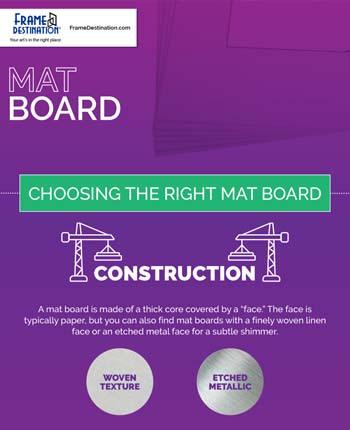Mat board is an essential part of a proper framing packaging. Most off-the-shelf frames do not include a mat, allowing the framed photograph or document to rest right against the glazing — causing irreversible damage. Photo mats, however, do more than separate the glazing from the art.
What Is Matboard?
A matboard rests just under the glazing but on top of the artwork. They serve not one, but two purposes:
It offers visual appeal by providing a strong border around the photograph or artwork, drawing the eye in. It’s often white or cream, but there are plenty of colors that can be used to perfectly complement the artwork.
It provides protection in a number of ways. One of the most important functions of a mat board is to separate the artwork from the glazing and help secure the artwork; however, the mat itself could pose its own problems. Certain materials, when in contact with photographic chemicals and paper, cause yellowing, fading and brittleness. If you are framing an item for what you hope to be a long time, it is important to make sure the materials are the right quality.
There are many options for framing mat board, which are available in numerous styles, colors and quality — the latter of which is rife with buzzwords. With so many options and so much terminology, it can be difficult to select the right one for your framing project.
Construction: How Is It Made?
Mat board is often not just a single sheet of paper; it comprises a core and face paper. The core makes up the majority of the material, and will most often be advertised as the main component. Face papers are exactly that — they are located on the outside (the face) of the mat board, and can be dyed or pigmented. When it is cut, the core is visible as it is often beveled. This is why some mat boards are available with a colored core and a white core.
While general consumers will be attracted to the available colors of the mat board, it is the material they are made with that is most important for those concerned with conservation.
A Note on Terminology
There are a number of terms surrounding mat board that are presumed to identify quality. However, there is no industry consensus on what these terms — conservation quality, museum quality, preservation grade, archival — mean.
The Library of Congress recommends, however, that to attain “preservation matting and framing,” the mat board must be:
- Made of 100% cotton rag or chemically purified, lignin-free wood pulp stock
- At least 4-ply
- pH neutral or slightly alkaline (pH 8.5)
- Pass the Photographic Activity Test (PAT) if framing photographs
What is Mat Board Made Of?
There are three types of materials: wood pulp, alpha-cellulose and cotton rag:
Wood pulp, or paper, mat board is the least expensive type of mat board material, but it comes in the widest variety of colors. This type of mat board is most often used in temporary framing or craft projects where preservation is not a concern.
Alpha-cellulose mat board is made from a specially processed paper pulp. Alpha cellulose mat board can be considered suitable for long-term framing, but it often does not meet museum standards that call for cotton rag mat board.
Cotton rag mat board is the highest quality mat board. Some cotton rag mat boards still contain a face paper, such as Crescent RagMat, while others are completely cotton rag mat board, such as Nielsen Alpharag and Crescent RagMat Museum.
How to Choose Colors
White and cream are the most popular mat board colors, as they offer a simpler, more refined style. Gallery exhibits often use white mat boards paired with black metal frames to offer a consistent theme that doesn’t detract from the artwork itself.
However, at-home framers often want more color options for a personalized style and to match home décor. Paper-based mat boards often have the widest variety of color options, as they aren’t meant for long-term framing; our white-core Papermat is offered in over 30 colors. However, the alpha-cellulose Bainbridge Alphamat, a conservation-quality (but not museum-quality, as it doesn’t meet the Library of Congress’s recommendation of cotton rag) mat board is available in nearly 30 colors. Though it’s not technically cotton rag, it is still suitable for long-term framing.
Selecting Thickness and Ply
The thickness of a mat board, indicated as “ply,” is often an afterthought when it comes to selecting a mat board. In general, 4-ply (1/16-inch thick) and 8-ply (1/8-inch thick) are the most common, but 6-ply is also available.
Thicker mat boards provide a sturdier surface, preventing it from warping and damaging the artwork, and more depth for greater visual appeal. The depth of an 8-ply mat board can also be achieved with two 4-ply mat boards in a “double mat.”
Higher ply mat boards are often more difficult to cut, resulting in wasted product when done incorrectly; it may be difficult for at-home framers to achieve the precision and clean lines that a professional service can. Many professional frame services, including Frame Destination, use computerized mat board cutting equipment to ensure that mat board sheets are cut exactly to size, and that the finishing touches — the beveled edge — are clean.
Which One Should You Choose?
Paper mat boards are the most economical choice, and come in the widest variety of colors. Museum-quality mats such as Crescent RagMat is for those who are primarily concerned with the safety of their artwork. Alpha-cellulose mat board is somewhere in the middle, combining archival materials with wide color options.
There are plenty of choices — what you select depends on your consideration for conservation, cost and aesthetics. View our entire selection of picture board including blank sheets as well as pre-cut mats.
Learn even more about frame mats with our mat board infographic.

Last updated January 3, 2022.

